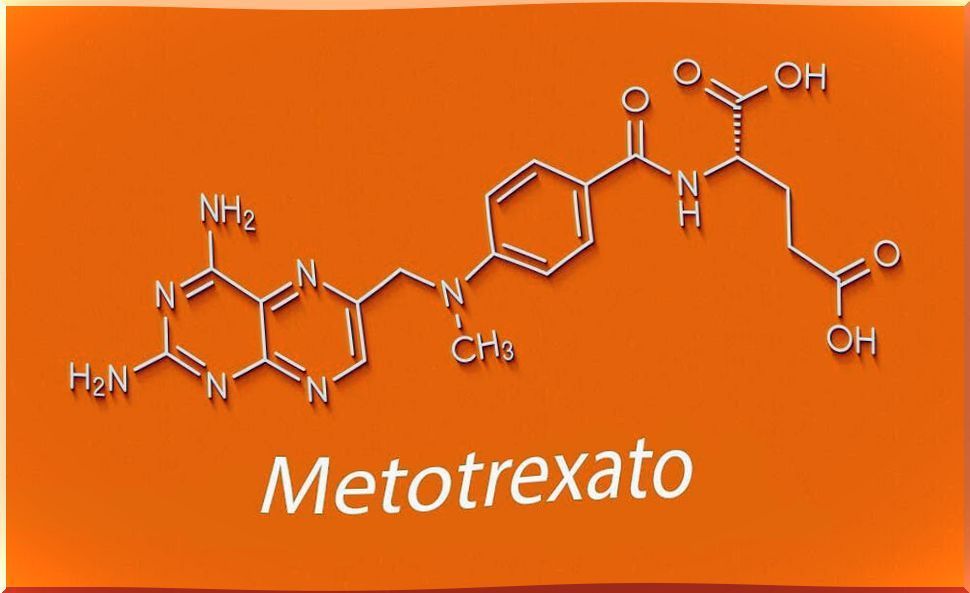Methotrexate: What It Is And How It Works
Methotrexate is a drug that belongs to a group of drugs called antimetabolites. This means that its structure is similar to that of molecules in our body (metabolites), which is why they bind to the same receptors.
If the drug is bound to the receptor, the parent metabolite cannot do so, thus reducing its effect. Methotrexate is a folic acid analog, also known as vitamin B9. It is used in the treatment of autoimmune diseases and as part of antineoplastic therapy.
What is folic acid?
Folic acid is a vitamin of plant origin, present in foods such as legumes or nuts. It is involved in the synthesis, repair and replication of DNA. Once ingested, folic acid is absorbed in the intestine and passes into the blood in the form of methyl-tetrahydrofolate, to later become tetrahydrofolate (THF).
DNA is made up of a double chain of molecules called nucleotides. The chains are joined together thanks to the unions that are established between the nitrogenous bases, structures that are part of the nucleotides.
There are four types of nitrogenous bases in DNA: adenine, thymine, guanine, and cytosine. Adenine and thymine are known as purines, and guanine and cytosine as pyrimidines. Tetrahydrofolate is involved in the synthesis of purine nucleotides. This means that a lack of folic acid will alter DNA synthesis, slowing down cell replication.
Mechanism of action of methotrexate

Methotrexate is a folic acid antimetabolite. The active form of folic acid is achieved after a reaction catalyzed by an enzyme called: dihydrofolate reductase. Methotrexate binds to this enzyme preventing THF from being activated, blocking cell proliferation.
Consequently, the effects of methotrexate are:
- Immunosuppressive effects, decreasing the activity of the immune system. Reduces lymphocyte action, especially that of B lymphocytes, responsible for the synthesis of antibodies. For this reason, methotrexate is used in the treatment of autoimmune diseases.
- Anti-inflammatory effects. Methotrexate lowers the levels of some cytokines, substances released during inflammatory reactions.
- Antifolate activity by inhibiting dihydrofolate reductase.
- Inhibition of other substances involved in folate metabolism.
It is administered orally or intravenously. Once in the blood, it binds to plasma proteins that transport it, being distributed throughout the tissues. Methotrexate can be abortifacient, so it should be avoided during pregnancy and lactation.
In addition, the liver and kidneys are involved in its metabolism and elimination. Consequently, its use should be monitored in patients with liver disease, especially alcoholic; and with kidney failure.
Indications of methotrexate

Methotrexate is used in low doses in the treatment of autoimmune diseases and in high doses associated with other anticancer drugs in antineoplastic therapy.
- Autoimmune diseases: in autoimmune diseases our immune system reacts against our body. Molecules called antibodies are synthesized that bind to cells or normal substances in our body and cause their destruction. We have said that methotrexate has anti-inflammatory effects and lowers antibody levels. From this fact, the usefulness of the drug in this type of disease can be deduced. For example, methotrexate is currently used to treat rheumatoid arthritis.
- Antineoplastic therapy: tumor cells are cells that have undergone different modifications that allow them to grow abnormally. Tumor growth is nothing more than uncontrolled cell division, for which large amounts of DNA are necessary. If we administer methotrexate, DNA synthesis decreases, so we control cell growth.
Methotrexate toxicity

One of the main drawbacks of the use of this drug is that its toxicity is high. In fact, methotrexate treatment requires analytical checks every 2-3 months. Toxicity manifests itself in different ways:
- Gastrointestinal toxicity. It is the most frequent form of toxicity, manifested by nausea, vomiting, loss of appetite and weight. Other symptoms such as ulcers or skin changes may be associated.
- Hepatic toxicity. It does not usually cause serious liver damage, but it may require a decrease in the dose of the drug. There is more risk if the patient had previous liver disease.
- Pulmonary toxicity. It is a serious type of toxicity, it can force to interrupt the treatment and apply respiratory support measures. It manifests with cough, dyspnea or shortness of breath, headache and general malaise.
- Spinal toxicity. The decrease in folic acid affects the synthesis of blood cells, producing a decrease in all of them. This term is called pancytopenia.
To reduce the toxic effects of the drug, folic acid or folinic acid (a derivative that does not need to be activated by dihydrofolate reductase) can be administered the day after treatment.
summarizing
As the NIH Cancer Dictionary states: “Methotrexate stops cells from using folic acid to make DNA and may kill cancer cells. In addition, it decreases the immune response of the body. Methotrexate is a type of antimetabolite and antifolate ”.









